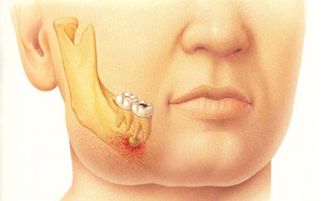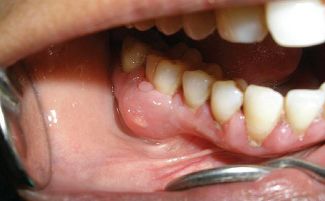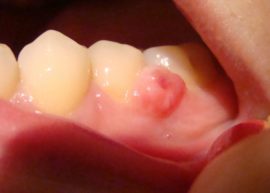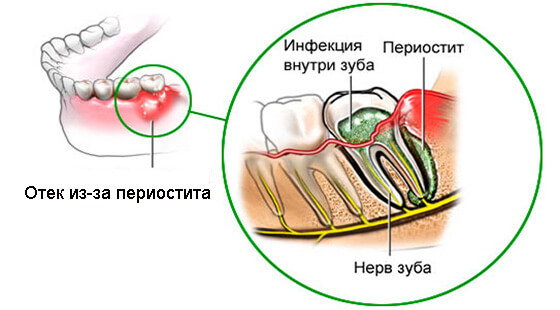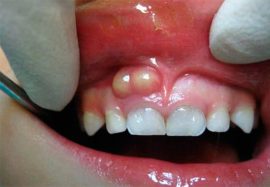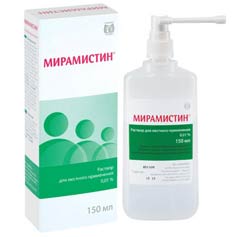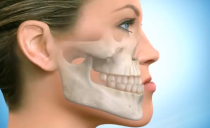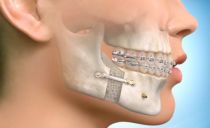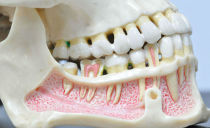Periostitis of the jaw: what is it and how to treat it
Injuries, infections of the oral cavity, untreated diseases - all this can provoke inflammatory process in the periosteum. The result will be periostitis of the lower jaw, which is popularly called flux. It is not difficult to get rid of the pathology, but the lack of adequate treatment threatens with numerous complications.
Content
Features of the disease
The disease affects the periosteum - the thin connective tissue that covers the surface of the bone. The inflammatory process provokes a thickening and subsequent peeling of the tissue. Between the periosteum and bone, a free space appears, filled with pus or serous fluid: the body is experiencing serious intoxication.
The main source of infection is carious cavities through which harmful microorganisms enter the apex of the roots of the teeth, after which they pass into the periodontal tissue and periosteum. Within a short time, a noticeable swelling develops.
The most dangerous is periostitis of the upper jaw: this is due to the risk of the transition of the inflammatory process to the sinuses. This is fraught with a large tumor, the wings of the nose, cheek and lower edges of the orbit may suffer. If the pathology affects the sinuses of the bone, the treatment process will be much more complicated. Edema can be localized in different areas:
- from the sky;
- on both sides;
- vestibularly.
Periostitis of the lower jaw is more common, and inflammation is usually located in the farthest teeth, eights are especially problematic. They collapse very quickly, and cleaning is complicated by a complex location. It is difficult for the patient to see carious lesions, and a slight swelling on the gum will be invisible.
Adults often suffer from periostitis of the jaw. In a child, such a disease manifests itself only if the body is already struggling with some kind of disease, and the immunity is greatly weakened.
Specialists distinguish two forms of the disease: acute and chronic. In the first case, the disease is accompanied by pronounced symptoms and a large amount of purulent exudate, in the second, the signs of pathology are blurred. Swelling of the soft tissues may be negligible, the course of the inflammatory process is sluggish.
Main symptoms
Symptoms of jaw periostitis depend on the form of the disease. It develops gradually, and over several days the patient may not suspect the onset of the inflammatory process. The first sign is a slight swelling in the area of the problem tooth. When pressing on the flux cone, pain occurs.
First, serous fluid appears in the cavity of the periosteum of the jaw. The following symptoms await the patient at this time:
- redness of the mucous membrane;
- a slight increase in temperature;
- the lymph node begins to become inflamed;
- asymmetry of the face, noticeable in the photo.
With the spread of infection in the absence of timely treatment, acute purulent periostitis develops. The general condition worsens significantly, new symptoms are added:
- obvious signs of intoxication appear;
- the temperature rises to 38 degrees;
- the pain intensifies;
- pulsation appears in the area of edema;
- the tumor is enlarged.
With a slight pressure on the swelling, fluctuation occurs - it seems that the fluid is oscillating.The acute stage is characterized by the appearance of a fistula: an unnatural opening through which purulent fluid will flow.
If the serous periostitis of the jaw can proceed unnoticed, then purulent can not be ignored. The pain has a rare pulsating character and intensifies as the space between the bone and periosteum is filled. When the fistulous course appears, the symptoms temporarily weaken.
It is very dangerous to self-medicate at this stage, and the patient needs to see a doctor as soon as possible, especially when it comes to inflammation of the upper jaw. In unfavorable circumstances, an abscess may develop. Even with a fistula, part of the purulent fluid still remains in the soft tissues of the gums.
Photo of periostitis of the lower jaw:
Possible causes and diagnosis
Periostitis is not an independent disease, it always occurs against the background of other pathologies in the oral cavity. Even if before the tooth seemed healthy and did not cause concern, flux is an obvious sign of disturbance. Provocateurs of inflammation of the periosteum of the jaw can be:
- large periodontal pockets;
- complex caries;
- alikal periodontitis;
- trauma to the oral cavity;
- lymphogenous pathology of the periosteum;
- systemic diseases;
- facial tissue infections;
- open fractures.
Also, staphylococci - bacteria that constantly live in the oral cavity become the cause of the acute form. There is a certain biological norm for these microorganisms, and if the body is healthy, they do not bring harm. But with a decrease in immunity against the background of other diseases, bacteria begin to multiply actively, provoking an inflammatory process in the periosteum.
In a child, the causes of jaw periostitis are usually viral diseases, which include:
- measles;
- ARVI;
- angina;
- otitis;
- scarlet fever;
- flu.
In most cases, for an accurate diagnosis, a patient examination in dentistry is enough, less often local or panoramic radiography is required.
The clinical picture of jaw periostitis resembles a number of other diseases - osteomyelitis, phlegmon, sialadenitis.
A doctor can choose a treatment for inflammation of the lower jaw only after an accurate diagnosis is established. Therapy at home does not always bring the necessary relief, and the most effective option is the surgical opening and installation of drainage. If we are talking about running eights, you can not do without tooth extraction.
Complications
Chronic fear of dentists leads to the fact that the patient is trying in every possible way to delay the time of the visit to the doctor. After the onset of fistula and subsidence of symptoms, it may seem that the problem has been resolved on its own and can be dispensed with without specialist intervention. This is a big mistake: temporary relief does not guarantee complete recovery.
The lack of proper treatment of periostitis of the lower jaw is fraught with the following complications:
- osteomyelitis;
- mediastinitis;
- an abscess;
- phlegmon;
- transition to a chronic form;
- sepsis.
With osteomyelitis, a purulent-necrotic inflammatory process affects the surrounding bone tissue and bone marrow. Symptoms resemble ordinary flux - signs of intoxication appear, tissues swell, the area of the affected tooth hurts. Suppuration of the wound can develop rapidly, the tumor appears within a few hours.
Mediastinitis, an inflammatory process in fiber, is accompanied by fever, chills, and severe tachycardia. Compression of organs quickly manifests itself, the signs of which are shortness of breath and cough. The main danger of complications is the risk of death: according to statistics, in vivo mediastinitis is detected only in 20% of cases.
Phlegmon often appears with chronic periostitis, the purulent process goes to fatty tissue. The tumor does not have clear boundaries, and quickly spreads through the cells of the body.If you do not urgently begin treatment, the inflammation spreads to the bones, muscles and tendons. Any complications often pass not from the chronic, but from the acute stage.
The basic rules of treatment
Periostitis requires complex treatment, two main methods are used - conservative and surgical. The sooner the patient turns to dentistry, the easier it will be to get rid of inflammation. Any therapeutic measures should be carried out only under the supervision of a dentist.
Self-healing patients often think that they could get rid of the acute form of inflammation without the help of a dentist. With a fistula, pus leaves the cavity, and the tumor subsides, and the pain is muffled by anesthetics. Obvious symptoms of periostitis of the lower jaw temporarily disappear, an illusion of healing is created. But after a while, the gum begins to rot again. In large cities (such as Moscow or St. Petersburg), you can find a round-the-clock clinic in which you can remove inflammation at any time of the day.
One of the main prohibitions is an attempt to independently open a purulent formation. There are too many risks, and the probability of infection is very high. Pus can enter the bloodstream, and this leads not only to damage to neighboring tissues, but also is fraught with blood poisoning.
What the dentist will do
For serous inflammation of the lower periosteum, treatment is carried out without serious surgical intervention. The main task of the doctor is to clean the dental canals. With a significant tumor, drainage may be necessary, due to which the fluid can leave the cavity. In addition, medication is prescribed to help get rid of the inflammatory process.
If periostitis has passed into a purulent stage, more serious measures will be needed. Modern dentistry is aimed at preserving "natural" teeth, so the removal is carried out only in the most extreme case. To remove the disease, you will have to dissect the periosteum.
The inflamed area is pre-anesthetized with articaine or lidocaine drugs. The focus of inflammation is characterized by an acidic environment, which deprives the anesthetic of power.
After anesthesia, a periostotomy is performed: an incision is made along the transitional fold, capturing the periosteum. Pus will flow from this wound. A glove gum is installed at the site of the lesion, performing the role of drainage. If pus again forms in the patient's body, he will come to the surface thanks to an open wound.
After opening the cavity, it is necessary to rinse the mouth with an antiseptic solution. This will have to be done at home, especially if drainage is installed. A few days after cleaning, the patient returns to dentistry again so that the doctor evaluates the result of the procedure.
Timely intervention will save the tooth, if appropriate. Extraction is necessary if:
- the crown is too broken;
- a cyst was formed at the root;
- access to the tooth is complicated.
Also, many doctors prefer to get rid of a problematic deciduous tooth in time. Otherwise, the rudiments of the permanent can suffer, which will lead to a serious maxillary problem. Special attention is required to inflammation, which is ready to erupt (as in the photo): even if the tooth needs extraction, it will have to be postponed.
Drug treatment
One of the main tasks of the patient after surgical treatment of periostitis of the upper or lower jaw is to regularly treat the wound and rinse the oral cavity with antiseptic solutions. For these purposes, Dimexide with Oxacillin, Ethacridine, Chlorhexidine and Miramistin are suitable.
- antibiotics (Lincomycin, Oxacilin, Oletetrin);
- sulfonamides (sulfadimezin, norsulfazole);
- nitrofurans (Furadonin, Furazolidone);
- antihistamines;
- antibacterial;
- painkillers.
It will be useful to take vitamin-mineral complexes: this will provoke the strengthening of immunity and improve the general well-being of the patient with acute or chronic periostitis.
The dosage and duration of drug therapy is determined by the attending dentist. It is important to complete the course to the end: the only way you can be sure that the infection will not spread further and that there will not be a second exacerbation.
Folk remedies
It is impossible to cure jaw periostitis only with folk remedies, but with their help the patient will be able to alleviate the general condition. Medication antiseptic solutions are easily replaced with recipes for "home" medicine.
You can prepare a rinse liquid according to one of the following recipes:
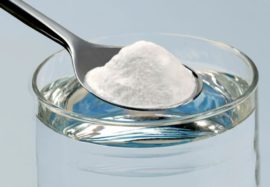 A tablespoon of soda in a glass (200 ml.) Of warm water. Everything is thoroughly mixed, rinse your mouth at the beginning of every hour or just keep the liquid in your mouth for 3-5 minutes.
A tablespoon of soda in a glass (200 ml.) Of warm water. Everything is thoroughly mixed, rinse your mouth at the beginning of every hour or just keep the liquid in your mouth for 3-5 minutes.- If chronic periostitis is very painful, you can remove the discomfort with soda and salt: dissolve a teaspoon in a glass of hot water and mix. The liquid can simply be poured into the mouth and used to rinse every 30-40 minutes.
- Four tablespoons of dry lemon balm per 0.4 liters. boiling water. Insist in a thermos for about four hours, cool before rinsing. It is advisable to use the broth during the day, the next day to cook everything anew.
- To relieve edema, a tablespoon of dry calamus root is poured with 500 ml of boiling water and put on fire. Boil the broth for about three minutes, then cool and strain. To enhance the effect adds a tablespoon of chopped dried sage or chamomile.
- Pour 250 ml of one sheet of scumpia. boiling water, insist 20 minutes. After strain and use to rinse 5-6 times a day. All fluid should go in a day, you can not store the infusion.
Severe periostitis of the jaw is always accompanied by acute pain. If the patient is not allergic to bee products, pain can be relieved by propolis: a cotton swab is moistened in tincture and applied to the affected area of the mucosa for 10-15 minutes.
It is worth remembering that not all folk remedies can be given to a small child. Before using any prescription, you must consult your doctor.
Prevention
Preventing jaw periostitis is much easier than curing it. The main way is regular preventive examinations in the clinic. Prevention visits are carried out at least once every six months. If there are any negative symptoms, you cannot postpone a visit to the dentist.
The easiest possible way to protect yourself from diseases of the oral cavity is a high-quality dental brushing at least twice a day, a maximum - after each meal. If there is no possibility to use a toothbrush, it is enough to at least rinse your mouth with clean water.
Use for cleaning you need high-quality toothpaste, and the brush is selected based on the condition of the teeth and gums. Rigid bristles are only suitable for dentures. If there is chronic periostitis, it is impossible to injure the tissue, and you need to choose an ultra-soft toothbrush. After cleansing, you can use a mouthwash.
You can keep your teeth and gums healthy thanks to proper nutrition and enough vitamins. Foods rich in calcium, fluoride and protein must be present in the diet. The teeth should receive a sufficient load, so “hard” vegetables and fruits are added to the daily menu.
If periostitis of the jaw has already been diagnosed, bad habits are completely eliminated. Alcohol and smoking weaken the body, damage the immune system and adversely affect the condition of the teeth and gums. Also in the list of "forbidden pleasures" are carbonated drinks, spices and sweets.
With a timely visit to the doctor, periostitis of the jaw lends itself well to treatment, and the pathological process can be removed in a few days.Careful attitude to one’s own health and regular visits to the dentist completely reduce the likelihood of illness to a minimum.


